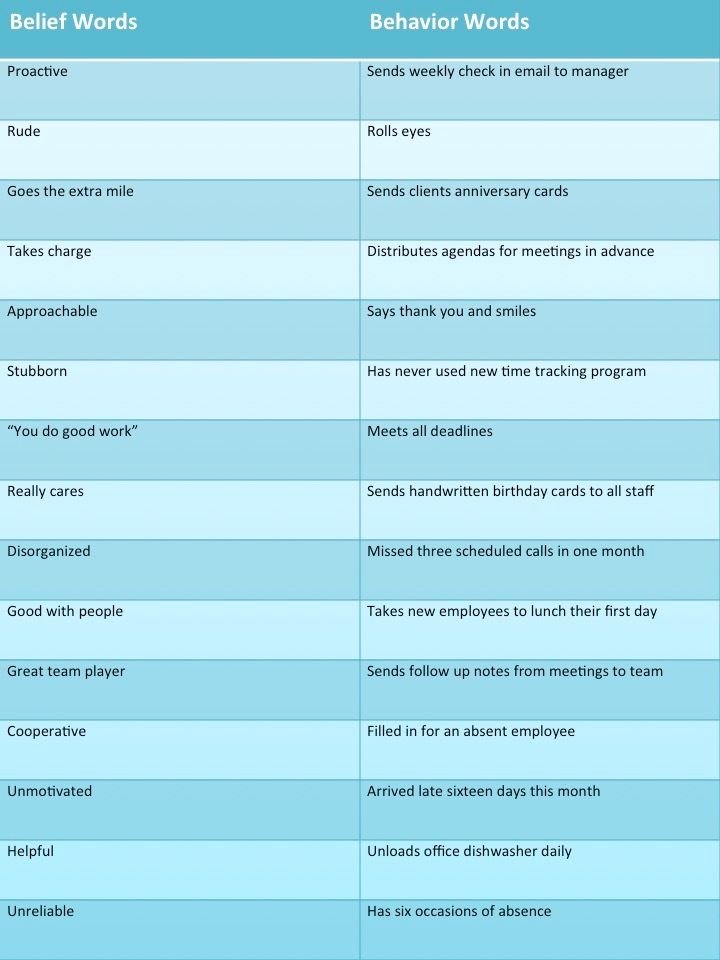Language plays a crucial role in managing teams and empowering people. Not only is unbiased language powerful, so is behavior language.
Let me explain. There are two types of language that is commonly used in organizations: behavior and belief language.
Here are the basic definitions of behaviors versus beliefs:
What Are Behaviors?
- Behaviors are what a person is doing
- Behaviors can be observed, heard or experienced
- Behaviors can be measured
What are Beliefs?
- Beliefs describe a person’s internal judgments about another
- Beliefs are not behaviors
- Beliefs are not directly visible or measurable
Behavior language is specific, measurable, uses more words and requires more thought before speaking. For example, “arrives at work at 7am,” is behavior language.
Belief language is shorter, uses less words, requires less thinking and is more commonly heard on a daily basis. An example of belief language is, “disrespectful.”
What’s problematic is that belief language is open to misinterpretation and miscommunication, whereas behavior language helps people understand exactly what is being discussed.
Then Why Didn’t You Say So?
For example, my manager might say, “Anne, I want you to be more organized.” Since the word ‘organized’ is open to interpretation, I might think my manager wants to me to come to meetings 15 minutes early. So that’s what I do. I’m then astonished when my manager comes to me a few weeks later and says, “Anne, I thought I told you to be more organized?” “But I am”, I reply. “I’m early for every single meeting.” My manager then explains, “I wanted you to have an agenda for every meeting, not come early.” “Then why didn’t you say so?!” I exclaim.
The entire miscommunication would have been avoided if my manager had said, “Anne, I want you create an agenda for every meeting.” Then she would be using behavior language rather than belief language.
With Belief Language, Only the Speaker Knows What the Word Means

The problem with belief language is that only the speaker knows what the word means, which causes communication challenges. The beauty of behavior language is that everyone in the room understands what exactly is meant and can act accordingly.
Some common belief language that I hear regularly is: team player, responsible, proactive, cooperative and unmotivated. Each of these words is open to interpretation; you might think a team player is someone who speaks up in each meeting, while I think a team player is someone who stays late every night. Javier may think Gwen is cooperative because she always agrees with him while I think she’s cooperative because she nods her head and listens. In these cases, it’s hard to measure if someone is improving behavior.
There is Usually a Behavior Language Underneath the Belief
Another reason belief language can be confusing at times is because there is usually a behavior underneath the belief. For example, I may see Zeke roll his eyes, and interpret the eye roll as a belief that Zeke is ‘rude’. I then start telling others that Zeke is rude, which Mel interprets in her own way as someone who interrupts others. So even though Mel has never worked with Zeke, she now thinks he will interrupt her, which is not true. Whereas if I just said that Zeke rolled his eyes at me, she would know exactly what I meant.
Let’s take a look at common belief and behavior words.
Why is this so important?

People can’t change behavior without specific, measurable language. Asking someone to be ‘more innovative’ is unclear and likely to lead to confusion. Asking someone to think of one new idea each day for seven days is a measurable behavior that may lead to increased innovation. Yet, as you can see, using behavior language takes more words and thought, which means you must be intentional when you speak.
What Does That Look Like?
So how do you change belief language into behavior language? Here’s the solution:
Ask, “What Does That Look Like?”
I ask this question many times a day, to ensure I understand what the person is asking me to do. If someone says, “I’d like you to help the team be more successful,” I will ask “What Does That Look Like?”
Warning: Some people may look at you curiously and say, “Everyone knows what successful is.”
When this happens, I just smile and say that I’d like to know their definition of success. Do they mean hitting revenue goals or client satisfaction goals? Do they mean in 2 months or 6 months? When I know that, then I know how to achieve the desired outcome.
Be Mindful of Your Language to Instigate Change
So be mindful of your language when talking to a client, colleague or employee. Are you setting up a potential miscommunication by using belief language? Or are you using specific examples that will lead to behavior change?
This lesson goes for our personal lives too, even when we are talking to ourselves. You may say, “I want to be less stressed at work,” yet continue to be stressed week after week. Remember to ask yourself, ‘what does that look like?’ Maybe it looks like leaving work on time daily, or doing yoga each morning, or taking a month-long vacation each year. Decide what the behavior is and work on that behavior. Soon you may just find that you’re not stressed at work anymore.
Can you give an example of one your personal goals, and what that goal “looks like?” This translation from belief language to behavior language may help others achieve similar goals. Leave a comment below, send me an email , or find me on Twitter .
Anne Loehr is a sought after international keynote speaker, writer, consultant, and trainer. She helps leaders in large organizations connect their everyday decisions today to the future workplace. Her end goal is to help organizations retain their top talent and not only survive, but thrive. To learn more about Anne, check out www.anneloehr.com or follow her on Twitter.
